Business Finance Report: Financial Statements, Ratios, and Performance
VerifiedAdded on 2023/06/18
|17
|2633
|116
Report
AI Summary
This report provides an analysis of applied business finance, focusing on the importance of financial management and the use of financial statements such as income statements, balance sheets, and cash flow statements. It discusses the significance of ratio analysis in assessing business performance, covering liquidity, solvency, and profitability ratios. The report also explores strategies businesses can employ to improve their financial performance, including optimizing payment methods and managing cash flow effectively. The content emphasizes the role of financial documents in understanding fiscal circumstances and enhancing decision-making, highlighting the importance of accurate data and strategic financial planning for sustained growth and profitability. Desklib offers additional resources, including past papers and solved assignments, for further study.

Applied Business Finance
Paraphrase This Document
Need a fresh take? Get an instant paraphrase of this document with our AI Paraphraser

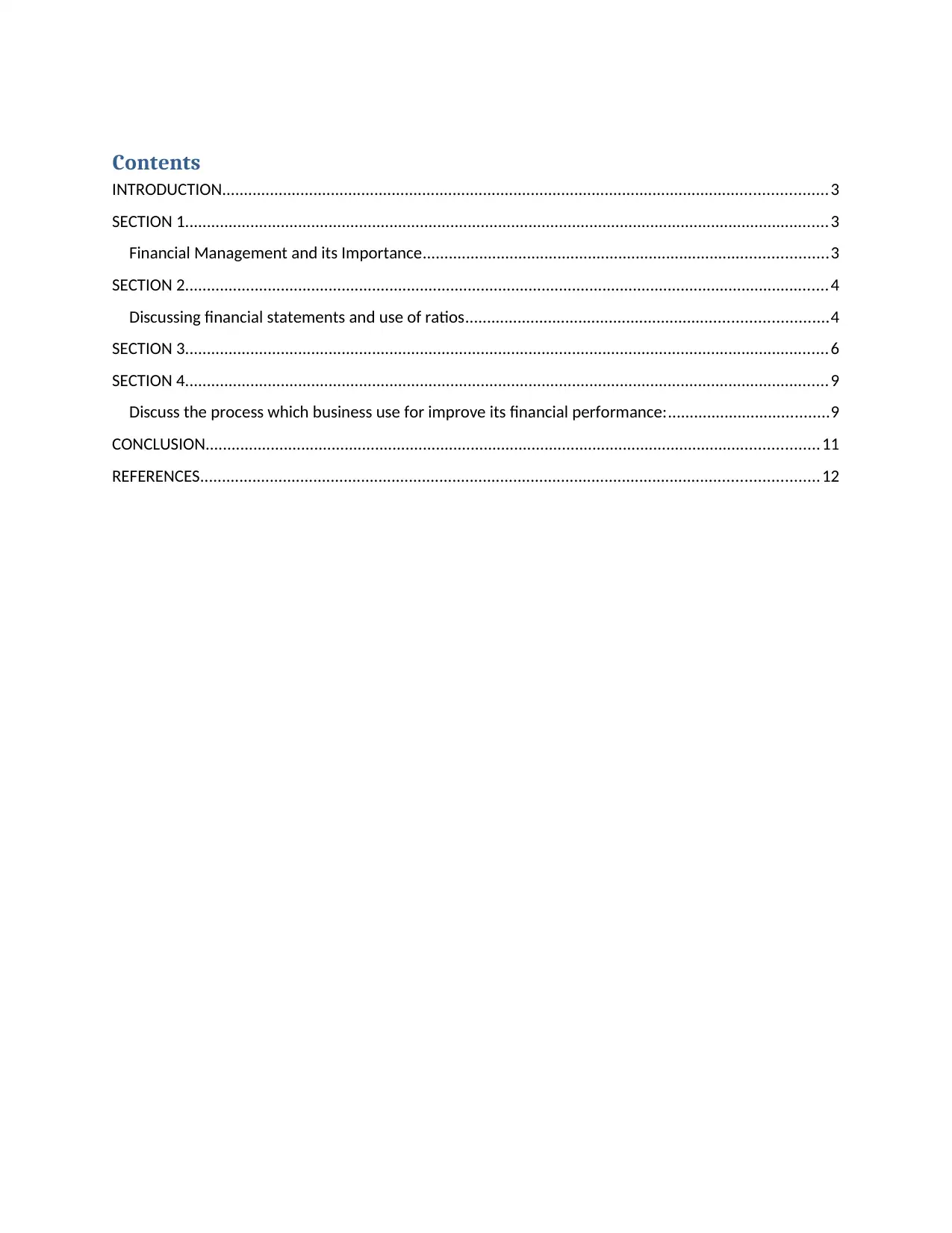
Contents
INTRODUCTION...........................................................................................................................................3
SECTION 1....................................................................................................................................................3
Financial Management and its Importance.............................................................................................3
SECTION 2....................................................................................................................................................4
Discussing financial statements and use of ratios...................................................................................4
SECTION 3....................................................................................................................................................6
SECTION 4....................................................................................................................................................9
Discuss the process which business use for improve its financial performance:.....................................9
CONCLUSION.............................................................................................................................................11
REFERENCES..............................................................................................................................................12
INTRODUCTION...........................................................................................................................................3
SECTION 1....................................................................................................................................................3
Financial Management and its Importance.............................................................................................3
SECTION 2....................................................................................................................................................4
Discussing financial statements and use of ratios...................................................................................4
SECTION 3....................................................................................................................................................6
SECTION 4....................................................................................................................................................9
Discuss the process which business use for improve its financial performance:.....................................9
CONCLUSION.............................................................................................................................................11
REFERENCES..............................................................................................................................................12
⊘ This is a preview!⊘
Do you want full access?
Subscribe today to unlock all pages.

Trusted by 1+ million students worldwide
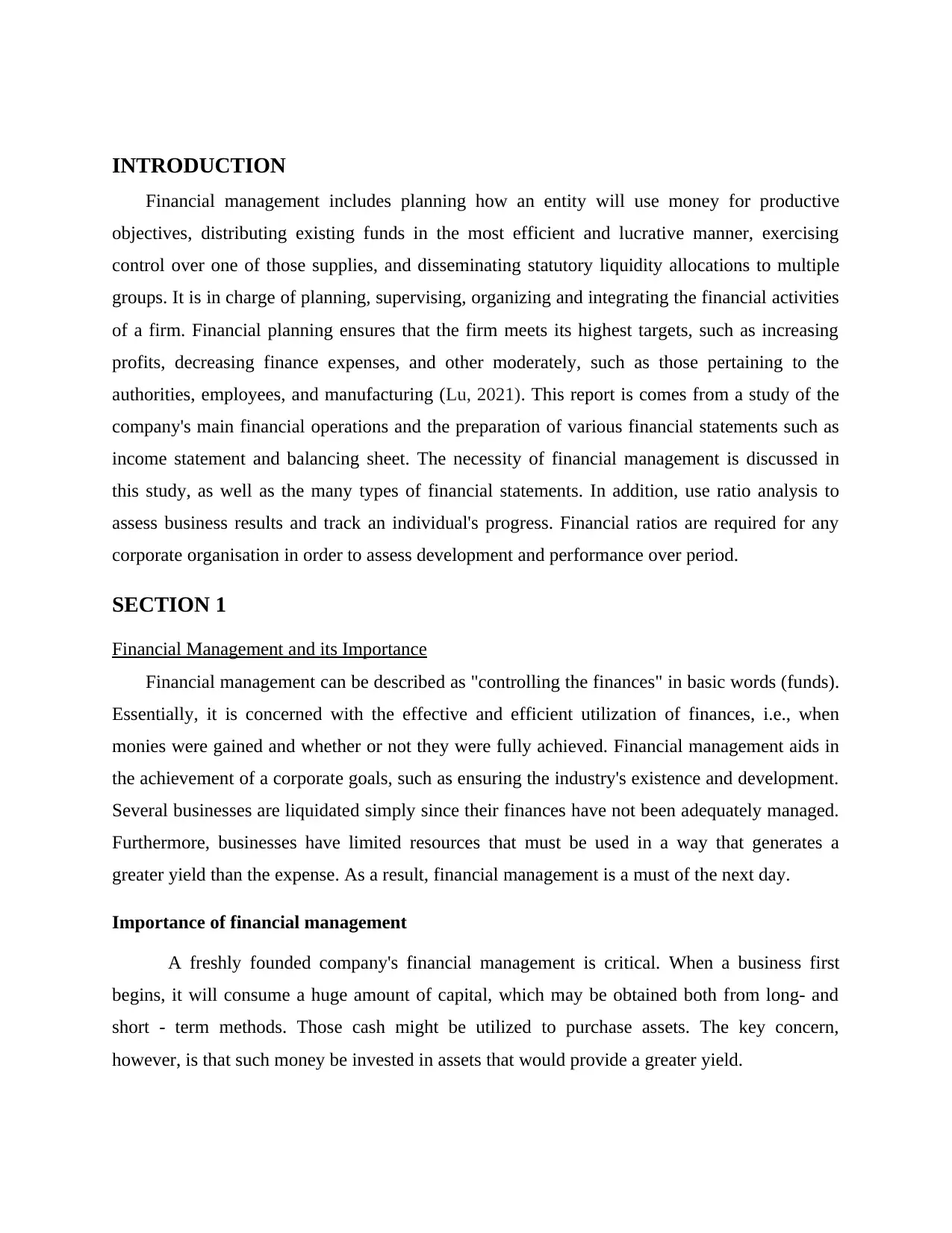
INTRODUCTION
Financial management includes planning how an entity will use money for productive
objectives, distributing existing funds in the most efficient and lucrative manner, exercising
control over one of those supplies, and disseminating statutory liquidity allocations to multiple
groups. It is in charge of planning, supervising, organizing and integrating the financial activities
of a firm. Financial planning ensures that the firm meets its highest targets, such as increasing
profits, decreasing finance expenses, and other moderately, such as those pertaining to the
authorities, employees, and manufacturing (Lu, 2021). This report is comes from a study of the
company's main financial operations and the preparation of various financial statements such as
income statement and balancing sheet. The necessity of financial management is discussed in
this study, as well as the many types of financial statements. In addition, use ratio analysis to
assess business results and track an individual's progress. Financial ratios are required for any
corporate organisation in order to assess development and performance over period.
SECTION 1
Financial Management and its Importance
Financial management can be described as "controlling the finances" in basic words (funds).
Essentially, it is concerned with the effective and efficient utilization of finances, i.e., when
monies were gained and whether or not they were fully achieved. Financial management aids in
the achievement of a corporate goals, such as ensuring the industry's existence and development.
Several businesses are liquidated simply since their finances have not been adequately managed.
Furthermore, businesses have limited resources that must be used in a way that generates a
greater yield than the expense. As a result, financial management is a must of the next day.
Importance of financial management
A freshly founded company's financial management is critical. When a business first
begins, it will consume a huge amount of capital, which may be obtained both from long- and
short - term methods. Those cash might be utilized to purchase assets. The key concern,
however, is that such money be invested in assets that would provide a greater yield.
Financial management includes planning how an entity will use money for productive
objectives, distributing existing funds in the most efficient and lucrative manner, exercising
control over one of those supplies, and disseminating statutory liquidity allocations to multiple
groups. It is in charge of planning, supervising, organizing and integrating the financial activities
of a firm. Financial planning ensures that the firm meets its highest targets, such as increasing
profits, decreasing finance expenses, and other moderately, such as those pertaining to the
authorities, employees, and manufacturing (Lu, 2021). This report is comes from a study of the
company's main financial operations and the preparation of various financial statements such as
income statement and balancing sheet. The necessity of financial management is discussed in
this study, as well as the many types of financial statements. In addition, use ratio analysis to
assess business results and track an individual's progress. Financial ratios are required for any
corporate organisation in order to assess development and performance over period.
SECTION 1
Financial Management and its Importance
Financial management can be described as "controlling the finances" in basic words (funds).
Essentially, it is concerned with the effective and efficient utilization of finances, i.e., when
monies were gained and whether or not they were fully achieved. Financial management aids in
the achievement of a corporate goals, such as ensuring the industry's existence and development.
Several businesses are liquidated simply since their finances have not been adequately managed.
Furthermore, businesses have limited resources that must be used in a way that generates a
greater yield than the expense. As a result, financial management is a must of the next day.
Importance of financial management
A freshly founded company's financial management is critical. When a business first
begins, it will consume a huge amount of capital, which may be obtained both from long- and
short - term methods. Those cash might be utilized to purchase assets. The key concern,
however, is that such money be invested in assets that would provide a greater yield.
Paraphrase This Document
Need a fresh take? Get an instant paraphrase of this document with our AI Paraphraser
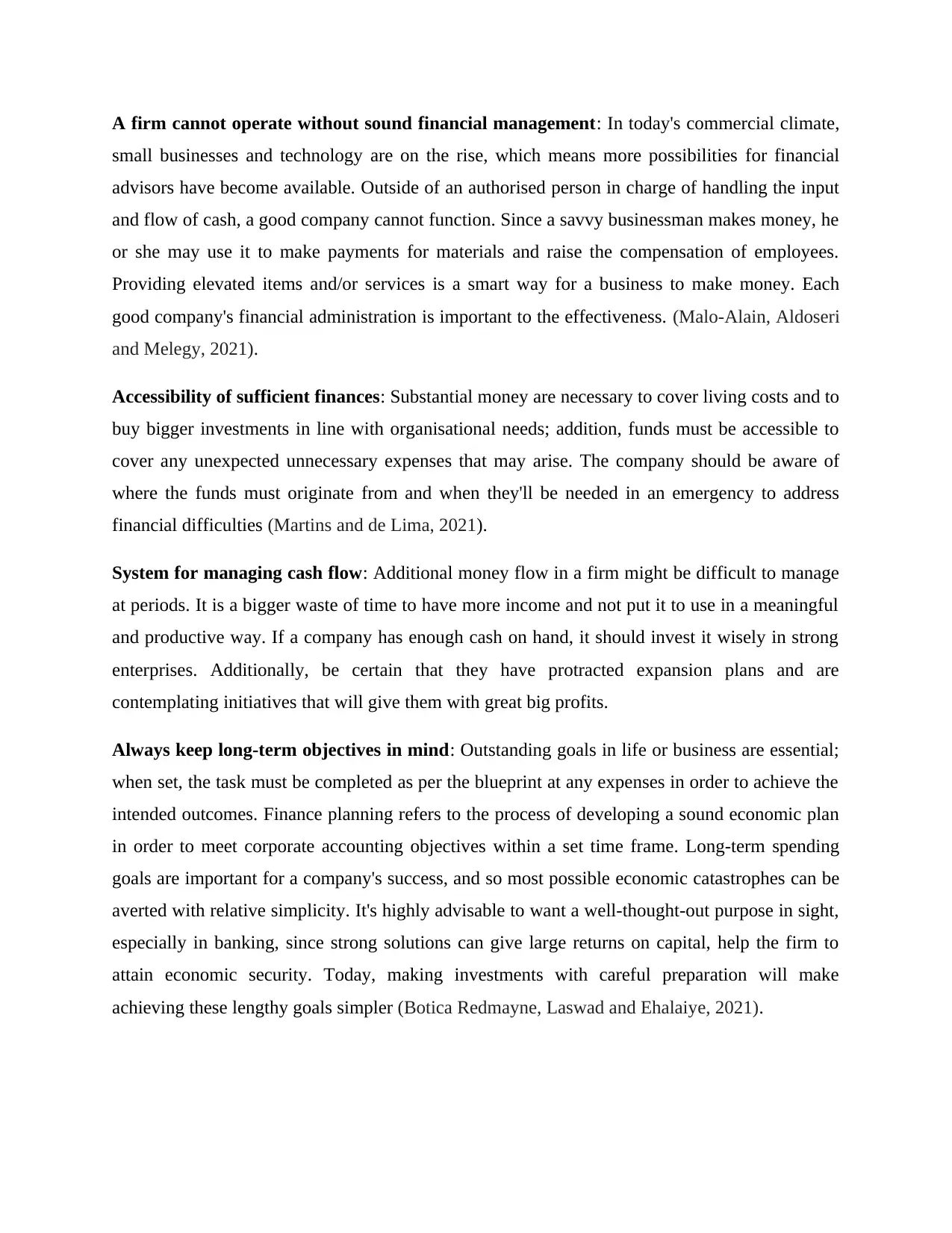
A firm cannot operate without sound financial management: In today's commercial climate,
small businesses and technology are on the rise, which means more possibilities for financial
advisors have become available. Outside of an authorised person in charge of handling the input
and flow of cash, a good company cannot function. Since a savvy businessman makes money, he
or she may use it to make payments for materials and raise the compensation of employees.
Providing elevated items and/or services is a smart way for a business to make money. Each
good company's financial administration is important to the effectiveness. (Malo-Alain, Aldoseri
and Melegy, 2021).
Accessibility of sufficient finances: Substantial money are necessary to cover living costs and to
buy bigger investments in line with organisational needs; addition, funds must be accessible to
cover any unexpected unnecessary expenses that may arise. The company should be aware of
where the funds must originate from and when they'll be needed in an emergency to address
financial difficulties (Martins and de Lima, 2021).
System for managing cash flow: Additional money flow in a firm might be difficult to manage
at periods. It is a bigger waste of time to have more income and not put it to use in a meaningful
and productive way. If a company has enough cash on hand, it should invest it wisely in strong
enterprises. Additionally, be certain that they have protracted expansion plans and are
contemplating initiatives that will give them with great big profits.
Always keep long-term objectives in mind: Outstanding goals in life or business are essential;
when set, the task must be completed as per the blueprint at any expenses in order to achieve the
intended outcomes. Finance planning refers to the process of developing a sound economic plan
in order to meet corporate accounting objectives within a set time frame. Long-term spending
goals are important for a company's success, and so most possible economic catastrophes can be
averted with relative simplicity. It's highly advisable to want a well-thought-out purpose in sight,
especially in banking, since strong solutions can give large returns on capital, help the firm to
attain economic security. Today, making investments with careful preparation will make
achieving these lengthy goals simpler (Botica Redmayne, Laswad and Ehalaiye, 2021).
small businesses and technology are on the rise, which means more possibilities for financial
advisors have become available. Outside of an authorised person in charge of handling the input
and flow of cash, a good company cannot function. Since a savvy businessman makes money, he
or she may use it to make payments for materials and raise the compensation of employees.
Providing elevated items and/or services is a smart way for a business to make money. Each
good company's financial administration is important to the effectiveness. (Malo-Alain, Aldoseri
and Melegy, 2021).
Accessibility of sufficient finances: Substantial money are necessary to cover living costs and to
buy bigger investments in line with organisational needs; addition, funds must be accessible to
cover any unexpected unnecessary expenses that may arise. The company should be aware of
where the funds must originate from and when they'll be needed in an emergency to address
financial difficulties (Martins and de Lima, 2021).
System for managing cash flow: Additional money flow in a firm might be difficult to manage
at periods. It is a bigger waste of time to have more income and not put it to use in a meaningful
and productive way. If a company has enough cash on hand, it should invest it wisely in strong
enterprises. Additionally, be certain that they have protracted expansion plans and are
contemplating initiatives that will give them with great big profits.
Always keep long-term objectives in mind: Outstanding goals in life or business are essential;
when set, the task must be completed as per the blueprint at any expenses in order to achieve the
intended outcomes. Finance planning refers to the process of developing a sound economic plan
in order to meet corporate accounting objectives within a set time frame. Long-term spending
goals are important for a company's success, and so most possible economic catastrophes can be
averted with relative simplicity. It's highly advisable to want a well-thought-out purpose in sight,
especially in banking, since strong solutions can give large returns on capital, help the firm to
attain economic security. Today, making investments with careful preparation will make
achieving these lengthy goals simpler (Botica Redmayne, Laswad and Ehalaiye, 2021).
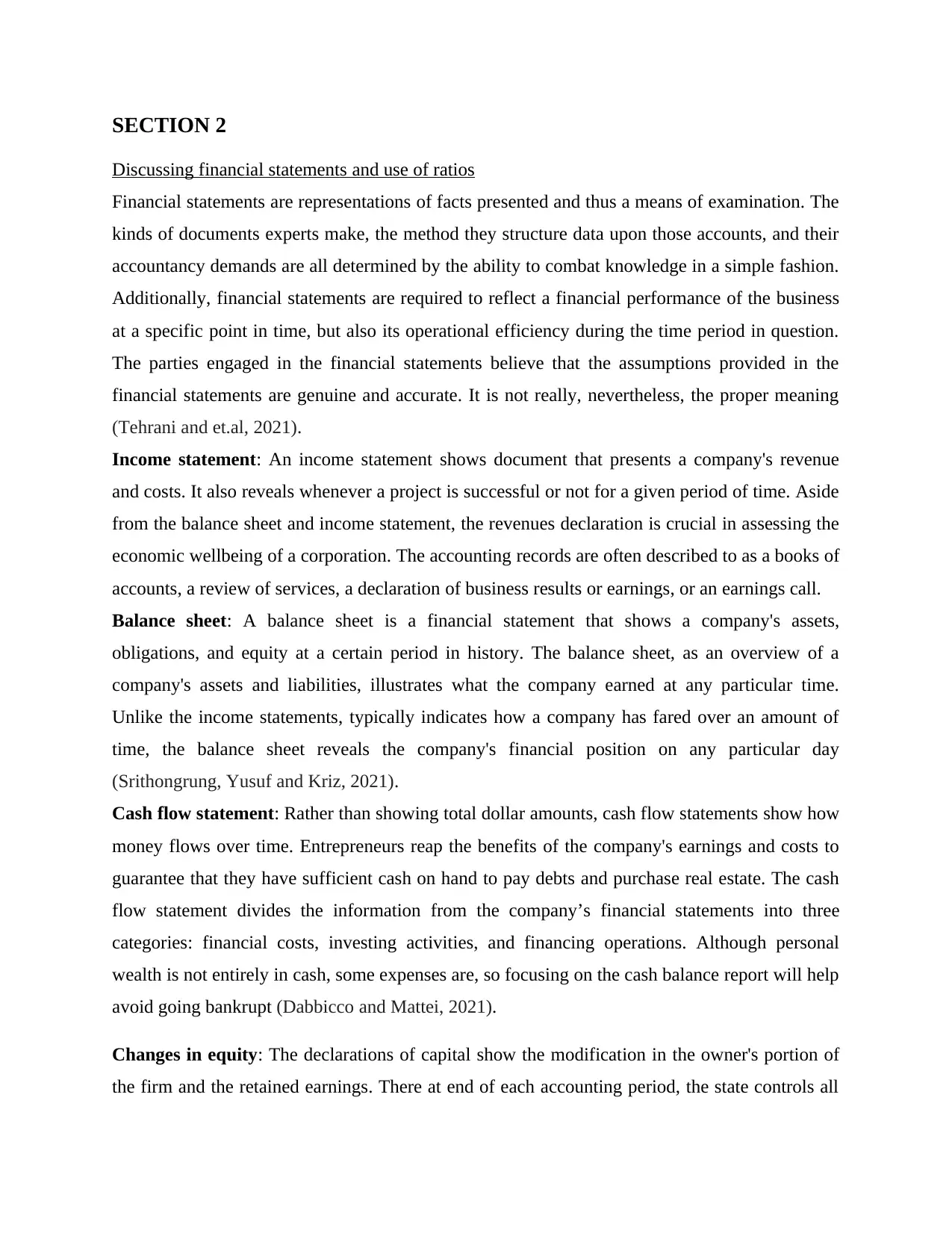
SECTION 2
Discussing financial statements and use of ratios
Financial statements are representations of facts presented and thus a means of examination. The
kinds of documents experts make, the method they structure data upon those accounts, and their
accountancy demands are all determined by the ability to combat knowledge in a simple fashion.
Additionally, financial statements are required to reflect a financial performance of the business
at a specific point in time, but also its operational efficiency during the time period in question.
The parties engaged in the financial statements believe that the assumptions provided in the
financial statements are genuine and accurate. It is not really, nevertheless, the proper meaning
(Tehrani and et.al, 2021).
Income statement: An income statement shows document that presents a company's revenue
and costs. It also reveals whenever a project is successful or not for a given period of time. Aside
from the balance sheet and income statement, the revenues declaration is crucial in assessing the
economic wellbeing of a corporation. The accounting records are often described to as a books of
accounts, a review of services, a declaration of business results or earnings, or an earnings call.
Balance sheet: A balance sheet is a financial statement that shows a company's assets,
obligations, and equity at a certain period in history. The balance sheet, as an overview of a
company's assets and liabilities, illustrates what the company earned at any particular time.
Unlike the income statements, typically indicates how a company has fared over an amount of
time, the balance sheet reveals the company's financial position on any particular day
(Srithongrung, Yusuf and Kriz, 2021).
Cash flow statement: Rather than showing total dollar amounts, cash flow statements show how
money flows over time. Entrepreneurs reap the benefits of the company's earnings and costs to
guarantee that they have sufficient cash on hand to pay debts and purchase real estate. The cash
flow statement divides the information from the company’s financial statements into three
categories: financial costs, investing activities, and financing operations. Although personal
wealth is not entirely in cash, some expenses are, so focusing on the cash balance report will help
avoid going bankrupt (Dabbicco and Mattei, 2021).
Changes in equity: The declarations of capital show the modification in the owner's portion of
the firm and the retained earnings. There at end of each accounting period, the state controls all
Discussing financial statements and use of ratios
Financial statements are representations of facts presented and thus a means of examination. The
kinds of documents experts make, the method they structure data upon those accounts, and their
accountancy demands are all determined by the ability to combat knowledge in a simple fashion.
Additionally, financial statements are required to reflect a financial performance of the business
at a specific point in time, but also its operational efficiency during the time period in question.
The parties engaged in the financial statements believe that the assumptions provided in the
financial statements are genuine and accurate. It is not really, nevertheless, the proper meaning
(Tehrani and et.al, 2021).
Income statement: An income statement shows document that presents a company's revenue
and costs. It also reveals whenever a project is successful or not for a given period of time. Aside
from the balance sheet and income statement, the revenues declaration is crucial in assessing the
economic wellbeing of a corporation. The accounting records are often described to as a books of
accounts, a review of services, a declaration of business results or earnings, or an earnings call.
Balance sheet: A balance sheet is a financial statement that shows a company's assets,
obligations, and equity at a certain period in history. The balance sheet, as an overview of a
company's assets and liabilities, illustrates what the company earned at any particular time.
Unlike the income statements, typically indicates how a company has fared over an amount of
time, the balance sheet reveals the company's financial position on any particular day
(Srithongrung, Yusuf and Kriz, 2021).
Cash flow statement: Rather than showing total dollar amounts, cash flow statements show how
money flows over time. Entrepreneurs reap the benefits of the company's earnings and costs to
guarantee that they have sufficient cash on hand to pay debts and purchase real estate. The cash
flow statement divides the information from the company’s financial statements into three
categories: financial costs, investing activities, and financing operations. Although personal
wealth is not entirely in cash, some expenses are, so focusing on the cash balance report will help
avoid going bankrupt (Dabbicco and Mattei, 2021).
Changes in equity: The declarations of capital show the modification in the owner's portion of
the firm and the retained earnings. There at end of each accounting period, the state controls all
⊘ This is a preview!⊘
Do you want full access?
Subscribe today to unlock all pages.

Trusted by 1+ million students worldwide
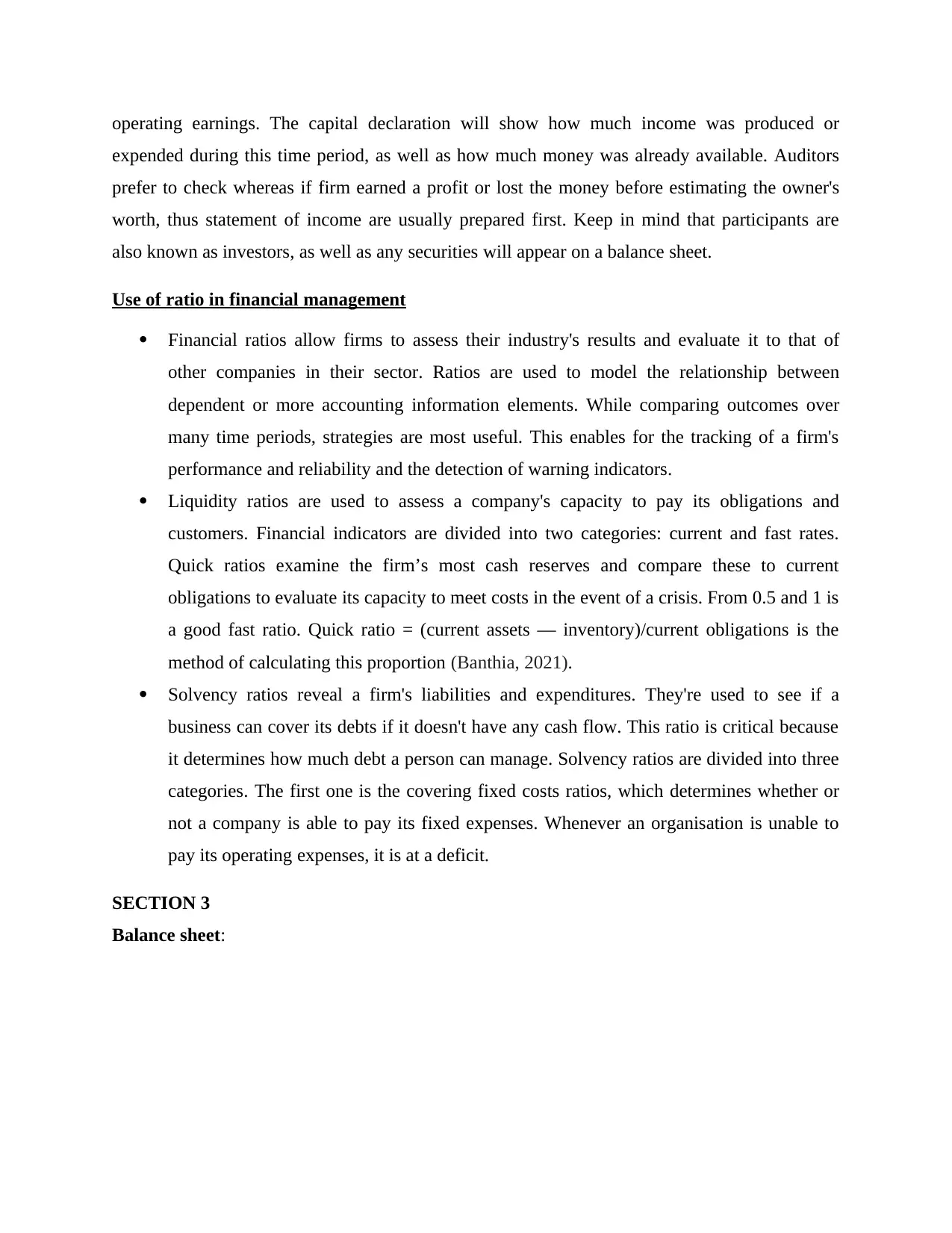
operating earnings. The capital declaration will show how much income was produced or
expended during this time period, as well as how much money was already available. Auditors
prefer to check whereas if firm earned a profit or lost the money before estimating the owner's
worth, thus statement of income are usually prepared first. Keep in mind that participants are
also known as investors, as well as any securities will appear on a balance sheet.
Use of ratio in financial management
Financial ratios allow firms to assess their industry's results and evaluate it to that of
other companies in their sector. Ratios are used to model the relationship between
dependent or more accounting information elements. While comparing outcomes over
many time periods, strategies are most useful. This enables for the tracking of a firm's
performance and reliability and the detection of warning indicators.
Liquidity ratios are used to assess a company's capacity to pay its obligations and
customers. Financial indicators are divided into two categories: current and fast rates.
Quick ratios examine the firm’s most cash reserves and compare these to current
obligations to evaluate its capacity to meet costs in the event of a crisis. From 0.5 and 1 is
a good fast ratio. Quick ratio = (current assets — inventory)/current obligations is the
method of calculating this proportion (Banthia, 2021).
Solvency ratios reveal a firm's liabilities and expenditures. They're used to see if a
business can cover its debts if it doesn't have any cash flow. This ratio is critical because
it determines how much debt a person can manage. Solvency ratios are divided into three
categories. The first one is the covering fixed costs ratios, which determines whether or
not a company is able to pay its fixed expenses. Whenever an organisation is unable to
pay its operating expenses, it is at a deficit.
SECTION 3
Balance sheet:
expended during this time period, as well as how much money was already available. Auditors
prefer to check whereas if firm earned a profit or lost the money before estimating the owner's
worth, thus statement of income are usually prepared first. Keep in mind that participants are
also known as investors, as well as any securities will appear on a balance sheet.
Use of ratio in financial management
Financial ratios allow firms to assess their industry's results and evaluate it to that of
other companies in their sector. Ratios are used to model the relationship between
dependent or more accounting information elements. While comparing outcomes over
many time periods, strategies are most useful. This enables for the tracking of a firm's
performance and reliability and the detection of warning indicators.
Liquidity ratios are used to assess a company's capacity to pay its obligations and
customers. Financial indicators are divided into two categories: current and fast rates.
Quick ratios examine the firm’s most cash reserves and compare these to current
obligations to evaluate its capacity to meet costs in the event of a crisis. From 0.5 and 1 is
a good fast ratio. Quick ratio = (current assets — inventory)/current obligations is the
method of calculating this proportion (Banthia, 2021).
Solvency ratios reveal a firm's liabilities and expenditures. They're used to see if a
business can cover its debts if it doesn't have any cash flow. This ratio is critical because
it determines how much debt a person can manage. Solvency ratios are divided into three
categories. The first one is the covering fixed costs ratios, which determines whether or
not a company is able to pay its fixed expenses. Whenever an organisation is unable to
pay its operating expenses, it is at a deficit.
SECTION 3
Balance sheet:
Paraphrase This Document
Need a fresh take? Get an instant paraphrase of this document with our AI Paraphraser
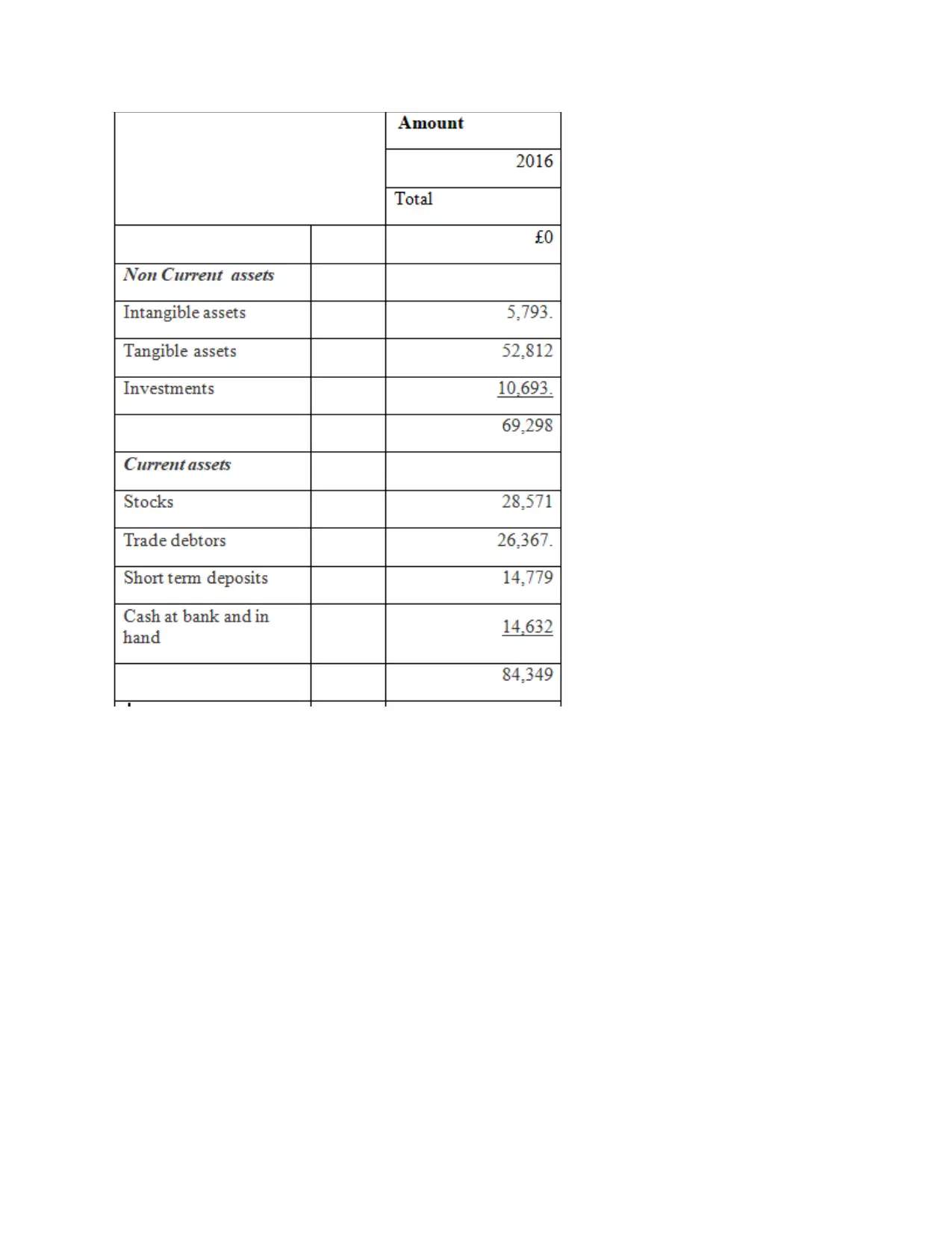
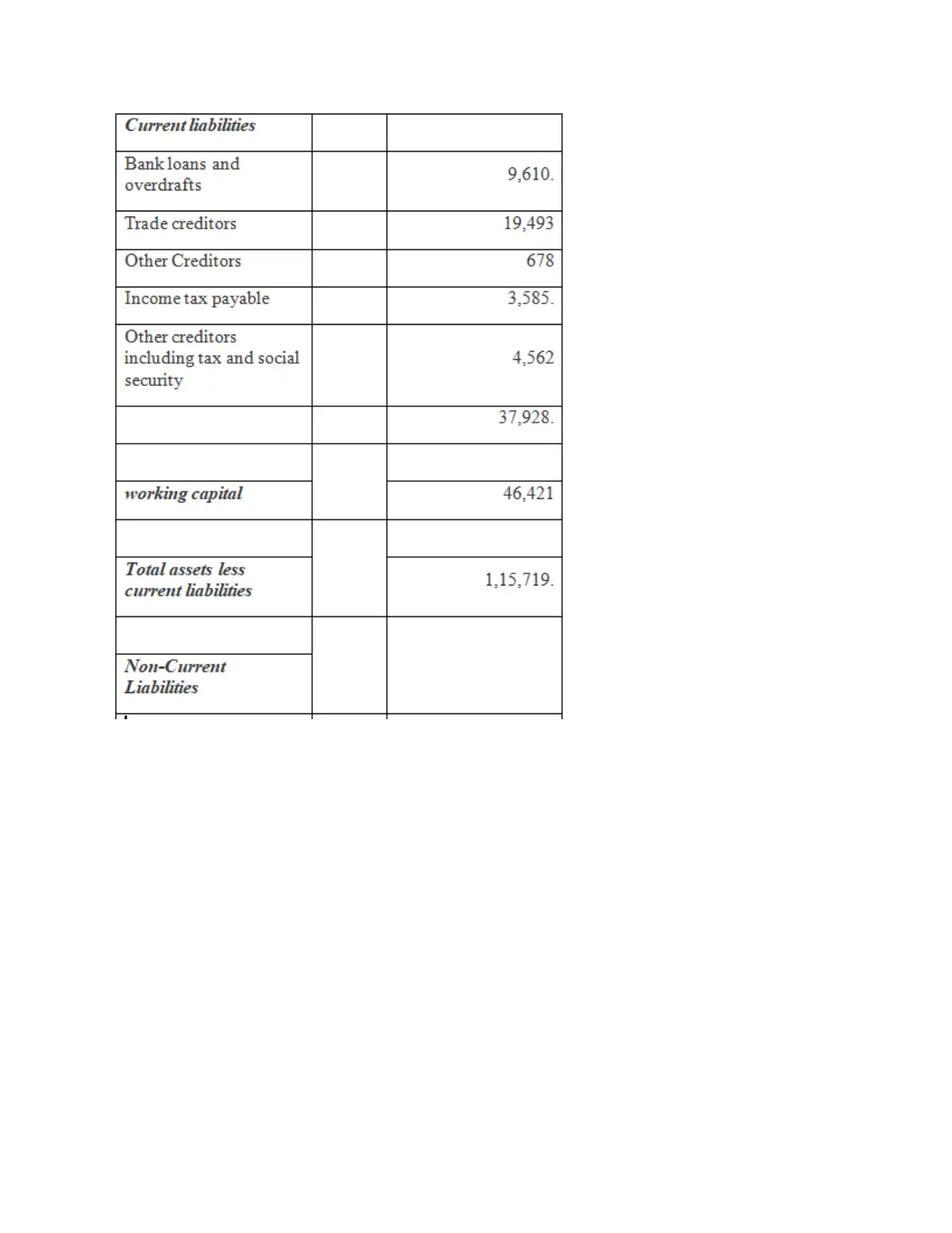
⊘ This is a preview!⊘
Do you want full access?
Subscribe today to unlock all pages.

Trusted by 1+ million students worldwide
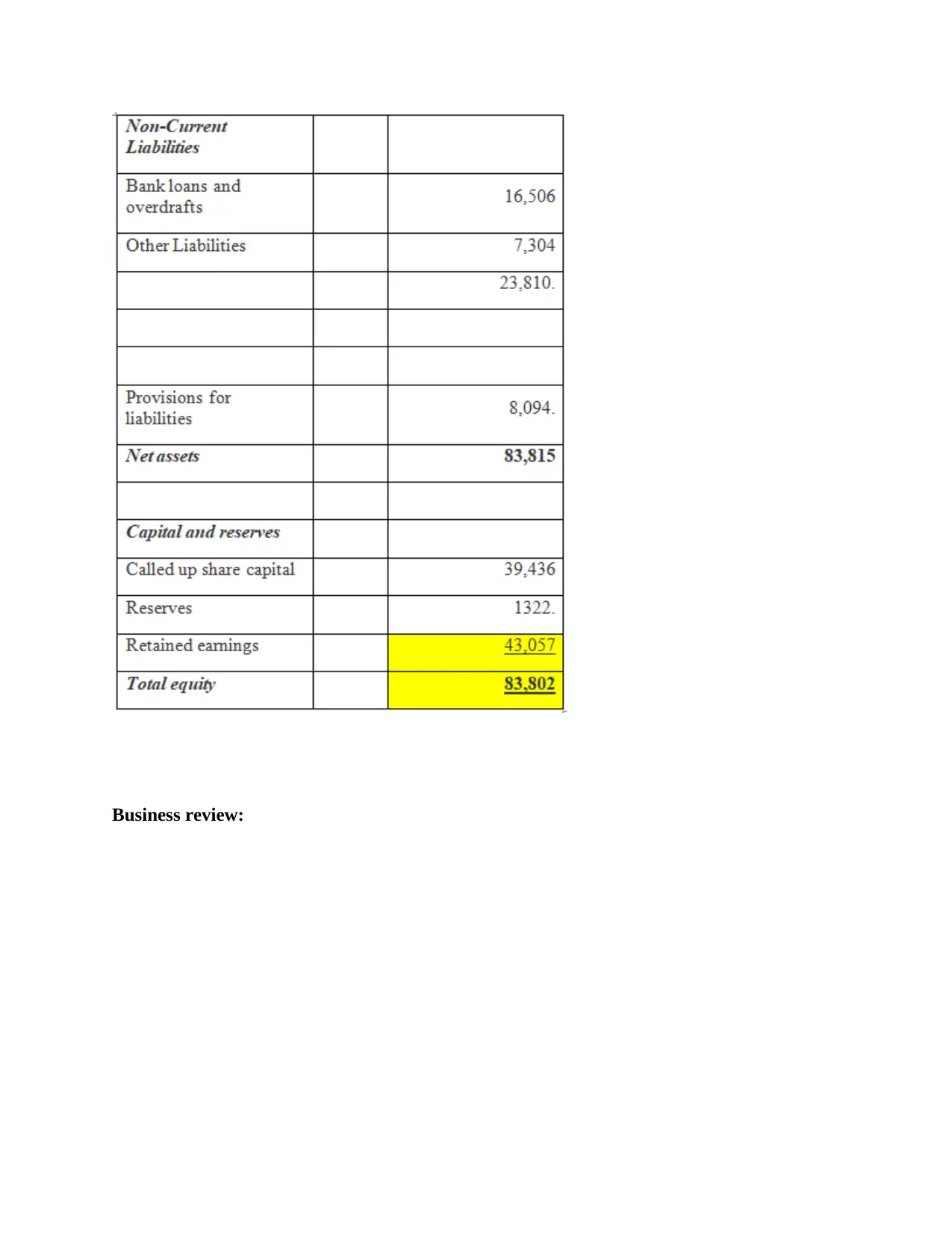
Business review:
Paraphrase This Document
Need a fresh take? Get an instant paraphrase of this document with our AI Paraphraser
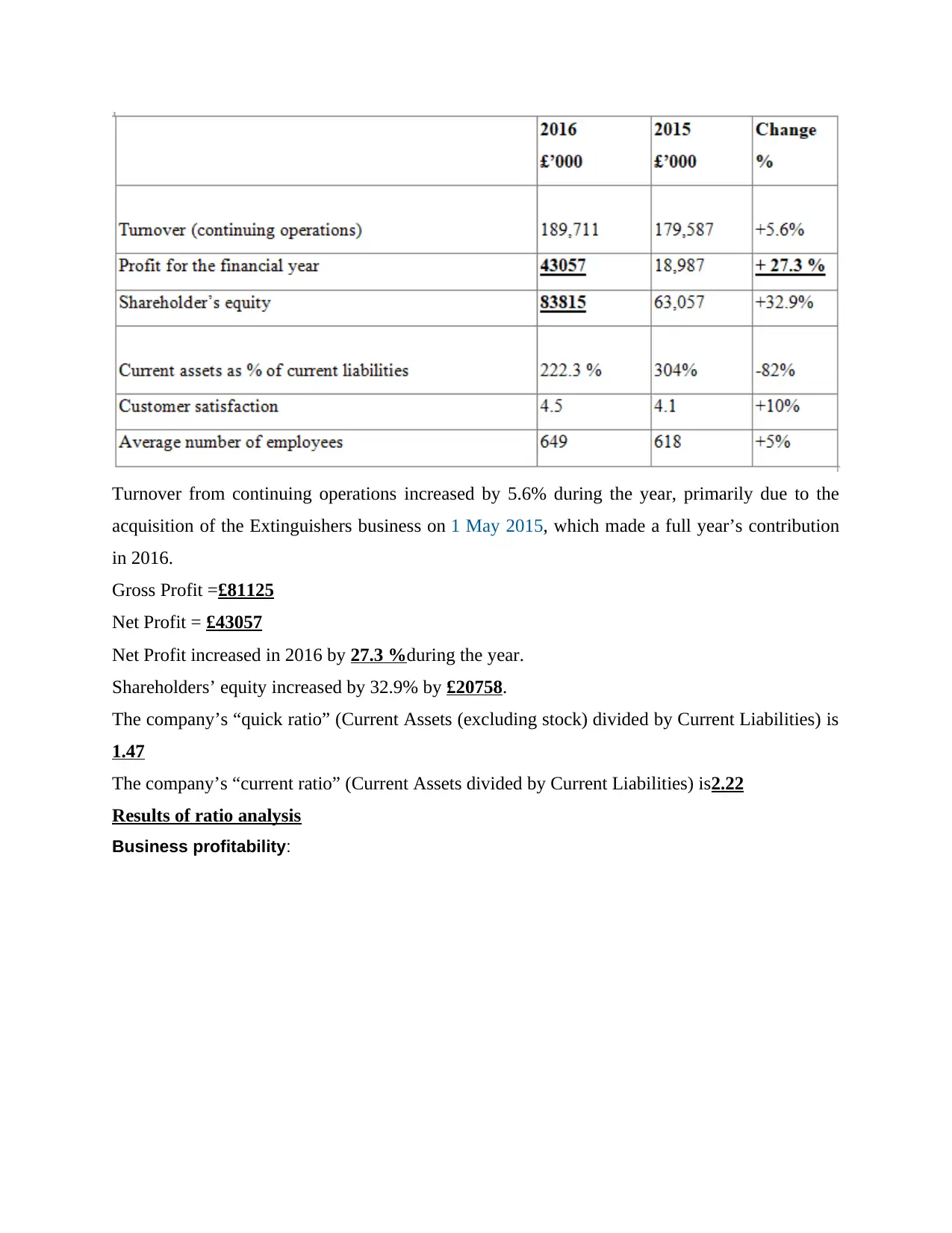
Turnover from continuing operations increased by 5.6% during the year, primarily due to the
acquisition of the Extinguishers business on 1 May 2015, which made a full year’s contribution
in 2016.
Gross Profit =£81125
Net Profit = £43057
Net Profit increased in 2016 by 27.3 %during the year.
Shareholders’ equity increased by 32.9% by £20758.
The company’s “quick ratio” (Current Assets (excluding stock) divided by Current Liabilities) is
1.47
The company’s “current ratio” (Current Assets divided by Current Liabilities) is2.22
Results of ratio analysis
Business profitability:
acquisition of the Extinguishers business on 1 May 2015, which made a full year’s contribution
in 2016.
Gross Profit =£81125
Net Profit = £43057
Net Profit increased in 2016 by 27.3 %during the year.
Shareholders’ equity increased by 32.9% by £20758.
The company’s “quick ratio” (Current Assets (excluding stock) divided by Current Liabilities) is
1.47
The company’s “current ratio” (Current Assets divided by Current Liabilities) is2.22
Results of ratio analysis
Business profitability:
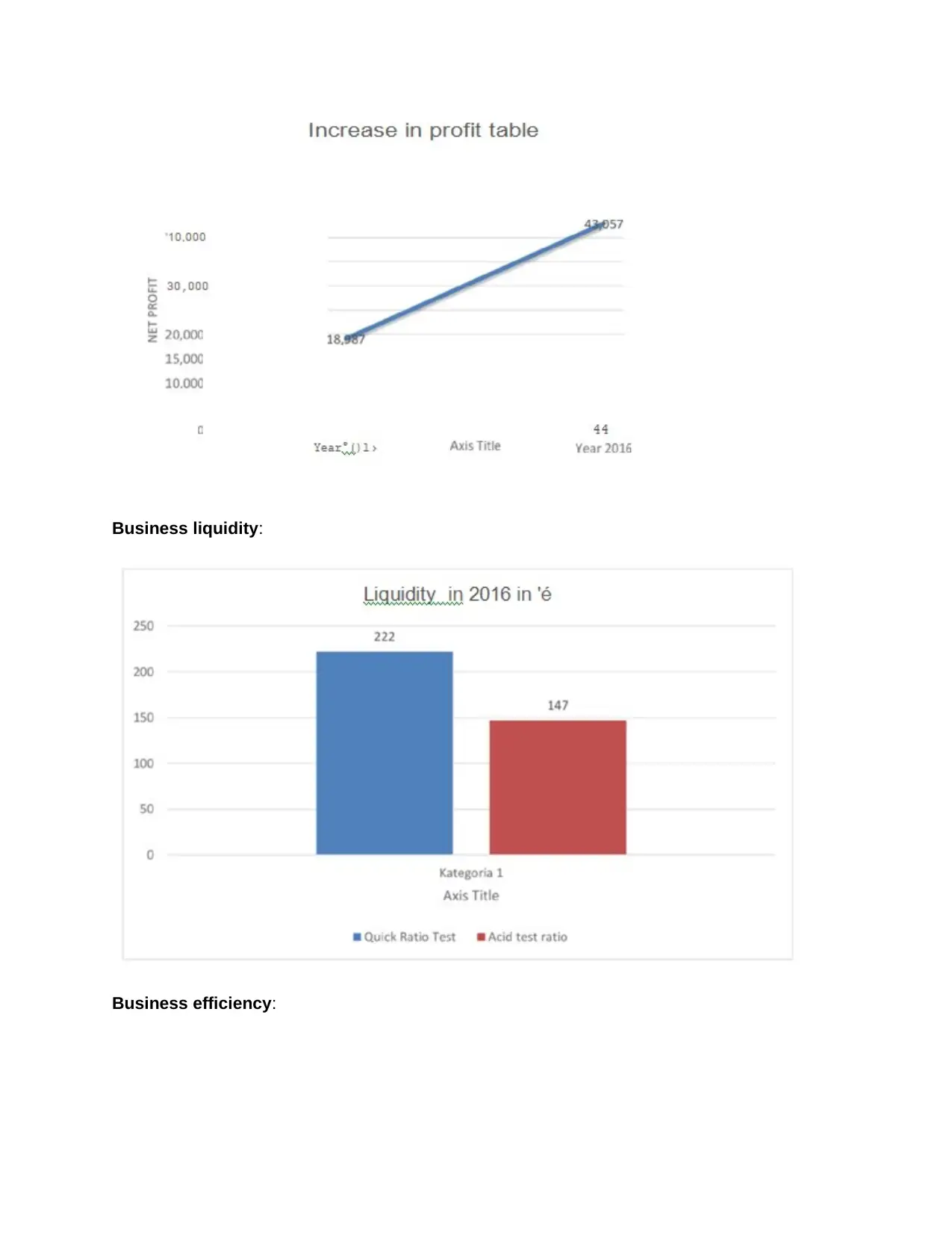
Business liquidity:
Business efficiency:
Business efficiency:
⊘ This is a preview!⊘
Do you want full access?
Subscribe today to unlock all pages.

Trusted by 1+ million students worldwide
1 out of 17
Related Documents
Your All-in-One AI-Powered Toolkit for Academic Success.
+13062052269
info@desklib.com
Available 24*7 on WhatsApp / Email
![[object Object]](/_next/static/media/star-bottom.7253800d.svg)
Unlock your academic potential
Copyright © 2020–2025 A2Z Services. All Rights Reserved. Developed and managed by ZUCOL.


